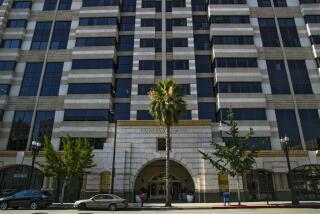Lessons: AN AUTOBIOGRAPHY by An Wang Ph.D. with Eugene Linden (Addison-Wesley: $17.95; 347 pp., illustrated)
- Share via
For more than 30 years, Wang Laboratories sustained one of the healthiest growth rates in the computer industry by introducing a number of innovative and successful products. Over the years, it grew into a $2.3-billion Fortune 150 company. But in 1985, the company reported a loss of $109 million, the first in more than a decade. The first quarter of 1986 witnessed another loss of $30 million. The company has laid off more than 3,000 employees, and there have been major changes and internal battles over the management of the company, including most recently, the controversial appointment of Fred Wang, the founder’s son, to president.
It is in these uncharacteristically troubled times for Wang Laboratories that An Wang, the 66-year-old founder, with his co-author Eugene Linden, sets out to chronicle his life of achievements and successes as an innovator, leader and businessman. This book makes little attempt to sort out the company’s troubled recent history; rather, it searches back through the laudable past for “lessons.”
The autobiography begins in Shanghai, where An Wang was born and grew up during the civil war and the invasion of the Japanese during World War II. He studied electrical engineering in China, then after the war, came to the United States in a technical apprenticeship program that eventually landed him at Harvard where he earned his Ph.D. in applied physics. In 1951, with $500 in savings, Wang left Harvard’s Computation Laboratory to launch his own company, Wang Laboratories.
Right from the outset, Wang’s one-man operation was pitted against IBM, which wanted to license his patent on magnetic core memories. This was Wang’s first and most important invention and led him into a crucial test of his business acumen.
With forthrightness not in evidence throughout the book, Wang describes in detail Big Blue’s negotiating tactics and sums them up as a “no-holds-barred style of competition,” which included in the midst of the negotiation a challenge to his patent pending by another inventor who Wang believes was put up to it by IBM. Most small businessmen would have been haunted by the nightmarish tactics of IBM, but Wang does not dwell on it; he takes the $400,000 IBM eventually paid for the license and simply goes on with his business, a business that would eventually grow large enough to compete with IBM on equal terms. Magnetic core memories went on to become a key component of most computers during the 1950s and 1960s.
Perhaps the key unstated lesson in this book about one man building a $2.3-billion company from scratch in a foreign country and mounting up the achievements that Wang has been attributed is as follows: Don’t let anyone or anything get to you. Don’t let outside forces penetrate your own, and if they do, don’t acknowledge it, even within yourself.
Wang Labs went on to introduce the Linasac phototypesetter; one of the first scientific and engineering logarithmic calculators called the LOCI; and a host of other calculators and computers, including the notable Wang word processing system. The driving force behind these inventions was Wang himself, though Wang is careful to give credit where credit is due. Wang succeeds in describing the technicalities of these inventions so that they are understandable to the general reader. Attached to each major shift or development in the company’s history, Wang provides, in a somewhat paternalistic manner, an instructive lesson that he learned.
More than setting out the secrets and truths behind the building of his company, Wang’s motivation for writing this book seems to be to bolster the morale of his 30,000 remaining employees. His “lessons” are to spur the company to thrive again.
At times, the book almost reads like a corporate history, lacking the critical depth, reflection, and insight that one might hope to find from one of the greatest innovators and businessmen of this century. This is in evidence as Wang discusses the troubled recent history of the company. He glosses over the critical period from 1976 to 1985 when the company suffered internally, key product introductions were delayed and Wang lost ground to IBM, Data General, and DEC in the office automation market.
He looks at the present state of the company in light of the past. “There have been stresses associated with the great growth spurt of the last eight years, but certainly none as threatening as those I faced in the early days of the company. The reason the company has been able to withstand the stresses of its evolution into a major industrial enterprise is that the spirit, or culture, of the company has not changed.” This book is clearly Wang’s attempt to rekindle the lost “spirit” of the company and help it withstand the stresses that seemingly mount everyday.
More to Read
Inside the business of entertainment
The Wide Shot brings you news, analysis and insights on everything from streaming wars to production — and what it all means for the future.
You may occasionally receive promotional content from the Los Angeles Times.










